ANSI / ASNT CP-189-2
016 ASNT standard for qualification of Nondestructive Testing.
ANSI / ASNT CP-189 is one of the ANSI-approved American National Standard.
ANSI / ASNT CP-189 establishes minimum requirements for the qualification and certification of nondestructive testing and predictive maintenance personnel and details the minimum training, education, and experience requirements for NDT personnel and provides criteria for documenting qualifications and certification.
Whereas
ASNT SNT-TC-1A establishes the general framework for a qualification and certification program. In addition, the document provides recommended educational, experience and training requirements for the different test methods.
DISCLAIMER
This article is written with reference to ANSI / ASNT CP-189-2016; however, this article only covers some essential points ANSI / ASNT CP-189-2016 in a more simplified manner for a better understanding of the Standard requirements among the people in NDT and Relevant Industry.
To learn more about ASNT SNT TC 1A read our blog:
BEGINNERS GUIDE TO NON DESTRUCTIVE TESTING (NDT) – UPDATED 2020
Scope
- This standard establishes the minimum requirements for the qualification and certification of nondestructive testing and predictive maintenance personnel.
- This standard details the minimum training, education, and experience requirements for NDT and provides criteria for documenting qualifications and certifications.
- This standard requires the employer to establish a procedure for the certification of NDT personnel.
- This standard requires that the employer incorporate any unique or additional requirements in the certification procedure.
As the above mention shows that ANSI/ASNT CP-189 is a standard establishing Minimum requirements which cannot be altered while making employer procedure for NDT Certification of NDT Personnel, unlike ANST STC TC 1A which provides guidelines for employers who want to establish in-house certification programs.
Moreover, ANSI/ASNT CP 189 also says that the employer should incorporate any unique or additional requirements in the certification procedure relevant to the there field in Industry. for example, nuclear corporations and aircraft manufacturing industries can have some unique or additional requirements in their procedure for NDT personnel certification as the parts to be inspected are very critical.
Important Definitions
Employer: The corporate, private, or public entity that employs personnel for wages or salary.
Predictive maintenance(PdM): evaluates the condition of equipment (Typically in service) by performing Periodic or continuous (online) equipment condition monitoring. The ultimate goal of PdM is to perform maintenance activities at a scheduled point in time when the maintenance activity is most cost-effective and before the equipment loses optimum performance or fails.
NDT Instructor: An individual qualified and designated in accordance with this standard to train or educate NDT personnel.
Levels of Qualification
There are six levels of qualification defined in terms of the skills and knowledge required in a given method or methods to perform specified NDT activities which are as follows:
- NDT Level III
- NDT Level II
- NDT Level II Limited
- NDT Level I
- Trainee
- NDT Instructor
NDT level III
NDT level III shall have skills and knowledge
- To establish techniques,
- To interpret codes, standards, and specifications,
- To designate the particular technique to be used,
- To verify the adequacy of procedures.
The individual shall also have a general familiarity with the NDT methods covered in Appendix A of ASNT CP 189.
The NDT Level III shall be capable of conducting or directing the training and examination of NDT personnel in the methods for which the NDT level III is qualified.
NDT Level II
An NDT Level II shall have the skills and knowledge
- to set up and calibrate equipment,
- to conduct a test,
- to interpret,
- to evaluate,
- and document results in accordance with procedures approved by an NDT level III.
The NDT Level II shall be thoroughly familiar with the scope and limitations of the method to which certified and should be capable of directing the work of trainees and NDT Level I personnel.
The NDT Level II Shall be able to organize and report nondestructive test results.
NDT Level II Limited
An NDT level II limited shall have the skills and knowledge
- to set up and calibrate equipment,
- to conduct a test,
- to interpret,
- to evaluate,
- and document results in accordance with the procedure approved by an NDT Level III in the techniques listed in Appendix B of ASNT CP189.
The NDT Level II Limited shall be thoroughly familiar with the scope and limitations of the method to which certified and should be capable of directing the work of trainees and NDT Level I personnel.
The NDT Level II Limited Shall be able to organize and report nondestructive test results.
NDT Level I
An NDT level I shall have the skills and knowledge
- To properly perform specific calibrations, Specific tests.
- With the prior written approval of the NDT level III, Perform specific interpretations and evaluations for acceptance or rejection and document the results, in accordance with specifically approved procedures.
NDT level I shall be able to follow approved nondestructive testing procedures and shall receive the necessary guidance or supervision from a certified NDT Level II or NDT Level III individual.
Trainee
A person who is not yet certified to any level shall be considered as a trainee. Trainees shall work with a certified person, under the direction of an NDT Level II or NDT Level III and shall not Independently conduct any test or write a report of test results.
NDT Instructor
An NDT instructor shall have the skills and knowledge to plan, organize and present classroom, laboratory, demonstration, and/or on the job NDT instruction, Training, and/or education programs in accordance with course outlines approved by an NDT Level III.
Qualification Requirements
Training and experience: candidates for certification as NDT Level I or NDT Level II shall complete sufficient organized training to become familiar with the principles of the method and the practices of the applicable test technique. This training shall be conducted in accordance with a course outline approved by an NDT Level III.
For NDT Level I and Level II: the minimum number of training hours and experience required for NDT Level I and Level II candidates is described in Appendices A and B in ANSI/ASNT CP 189, The course shall include the topics contained in ANSI/ASNT CP 105 for the appropriate NDT method, plus such additional topics as deemed necessary by the NDT Level III.
Credit: To receive credit for Training hours, the individual shall pass a final examination covering the topics contained in that program.
Presentation of Training: All training shall be presented by an NDT Instructor. However, the NDT instructor may use personnel with specialized expertise (For Ex: metallurgists, welding engineers, Etc.) who are not qualified in accordance with this standard to assist in the presentation of specific information. The NDT Level III shall be responsible for the content of the completed course.
NDT Instructor :
Designation: The NDT instructor shall be designated by an NDT Level III individual. The Designation shall become part of the individual’s Qualification Records.
An NDT instructor shall meet at least one of the following Criteria:
- Possess a current ASNT Level III certificate in the NDT method to be taught.
- Have academic credentials at least equivalent to a B.S in engineering, physical science, or technology, and possess adequate knowledge in the NDT method to be taught
- Be a graduate of a two-year school of science, engineering or NDT and have five or more years of experience as an NDT Level II, or equivalent, in the NDT method to be taught.
- Have 10 or more years of NDT experience as an NDT Level II, or equivalent, in the NDT method to be taught.
Vision Requirements
Near Distance: Prior to certification, NDT personnel shall be examined to ensure that they have natural or corrected near-distance acuity in at least one year such that each individual is capable of reading Jaeger Number 1 test chart or equivalent* at a distance of not less than 12 Inches.
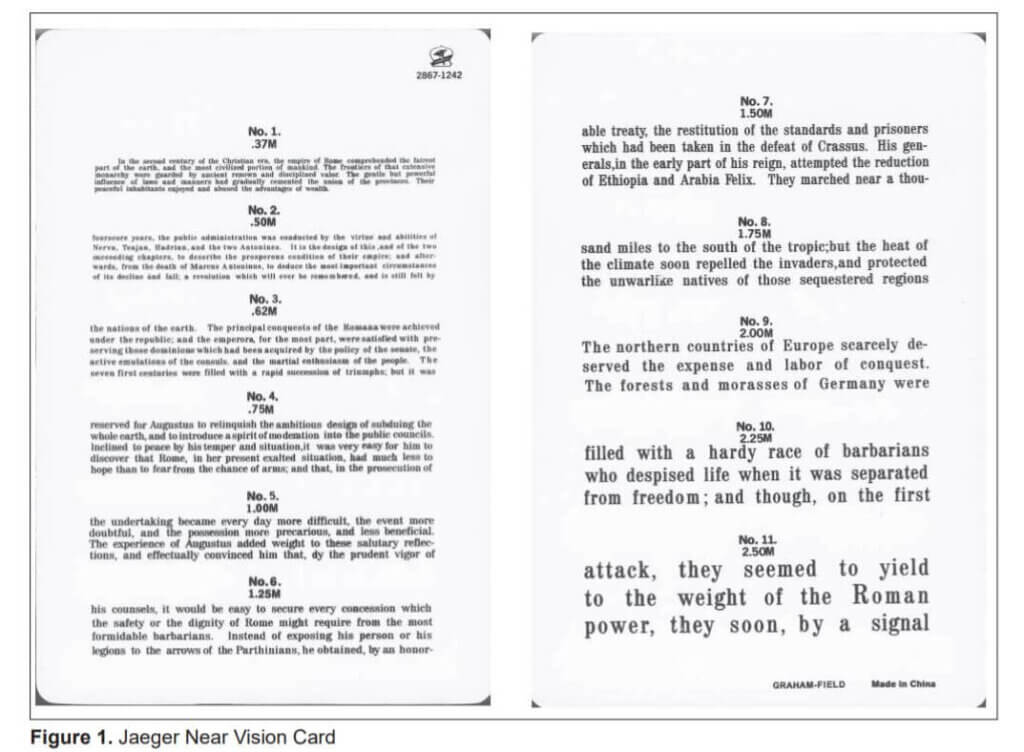
For Sample purposes only
https://pdfs.semanticscholar.org/b4b1/e8d57777dd1627c85b04fc17d72673ea17ca.pdf
*Equivalent eye examination results for jaeger J1 visual are; Snellen 20/22; Times Roman 3.5 Point Test; OrthoRater #9; or Titmus (SAB-1, SAL-1 or SAR-1) #10.
Color Vision: NDT personnel for all methods shall demonstrate the ability to differentiate among the colors or shades of gray used in the method.
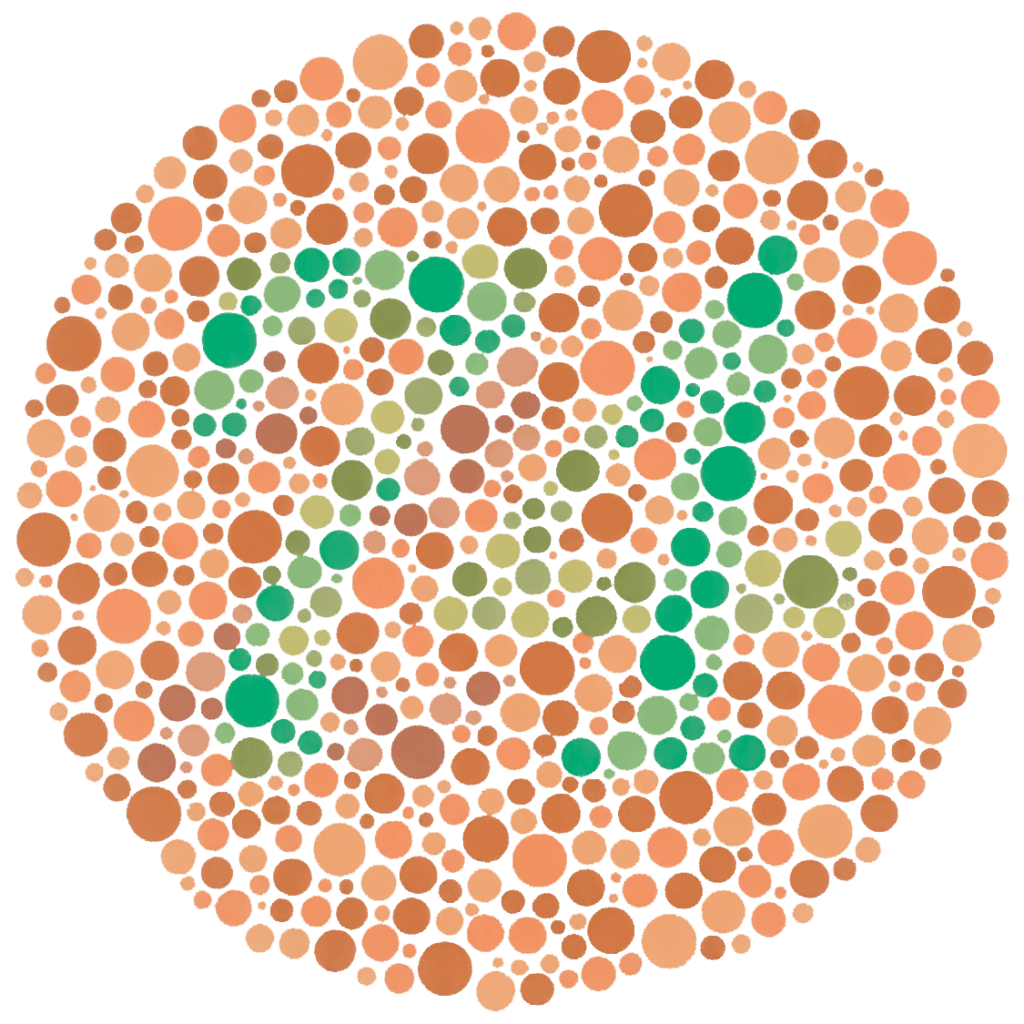
https://en.wikipedia.org/wiki/Color_blindness
Frequency: Vision examination shall be administered annually, except that color differentiation examinations need to be repeated only at each recertification. Vision examinations shall expire on the Last day of the month of Expiration.
NDT Level I and Level II Examinations
General Exam is a closed book exam approved by an NDT level III with a minimum number of questions mentioned in Table 1 in ASNT CP 189. Questions shall be developed which represent a cross-section of the body of knowledge contained in ANSI/ASNT CP 105 applicable to each method and NDT Level.
Specific examination approved by an NDT Level III. The examination shall address various examples of equipment, procedures, and test techniques that the candidate may use in the performance of assigned duties. The minimum number of questions required for each method and level as per Table 1 in ASNT CP 189.
Practical Examination shall be approved by an NDT level III, Administration shall be in accordance with 6.6 of ANSI/ASNT CP 189. The practical exam shall consist of the following:
- NDT Level I: the candidate shall demonstrate proficiency using the applicable nondestructive test method to examine at least one test sample for each technique to be used in the candidate’s job and by documenting the results of the test. The test samples shall be representative of the products that the candidate will encounter in performing the job functions.
- NDT Level II: The candidate shall demonstrate proficiency by performing the applicable NDT method in examining at least one sample per technique and a minimum of two samples per method and by interpreting, evaluating and documenting the results of the examination. The test samples shall be representative of the product that the candidate will encounter in performing the job functions.
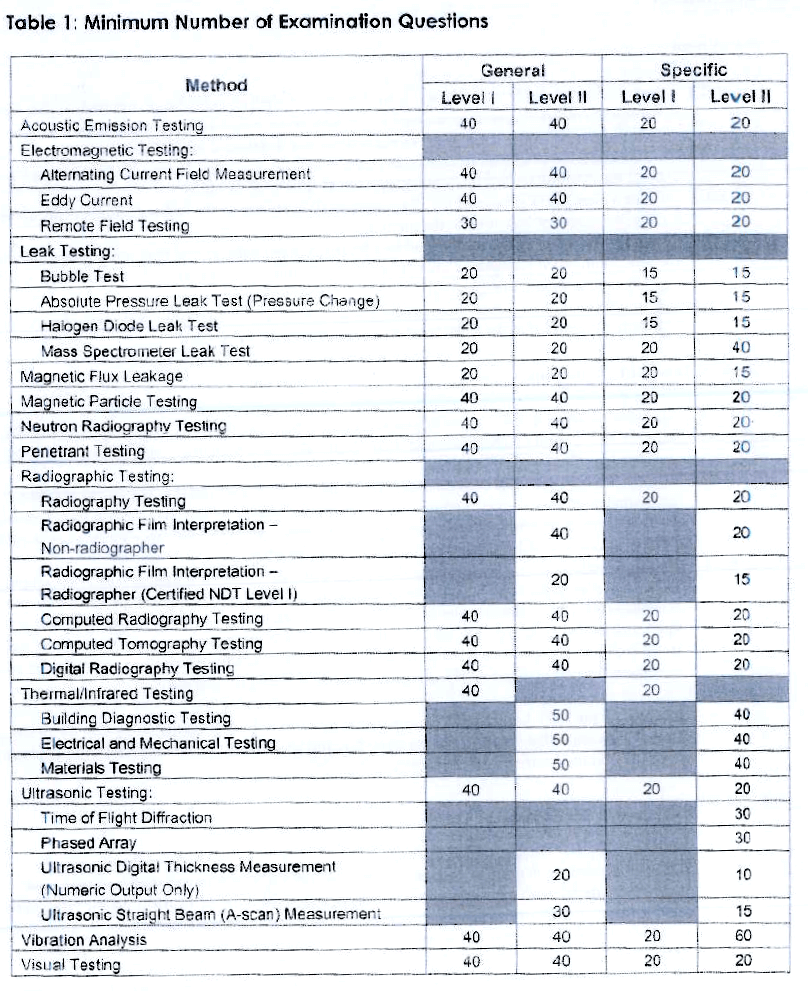
Employer Recertification
For NDT Level I and NDT Level II shall be recertified by re-examination in accordance with ANSI/ASNT CP 189.
- Every five years, the individual may be recertified if the individual has at least 350 hours of documented experience using the applicable method over the five-year certification interval and has successfully passed a specific examination which complies with ANSI/ASNT CP 189, clause 6.2.2.
- At least every 10 years, the individual must repeat the examinations in ANSI/ASNT CP 189 Section 6.
NDT Level III personal shall be recertified by the employer every five by verifying that the individuals ASNT Level III certificate in current in each method for which recertification is sought.
Important Tables
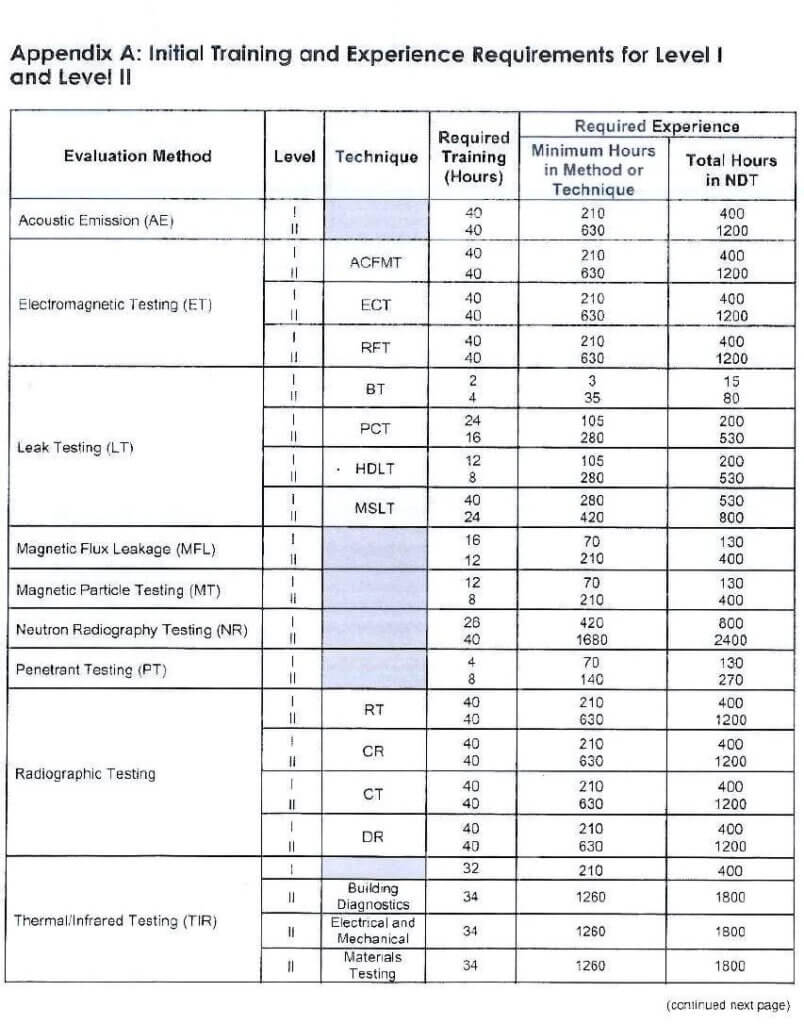
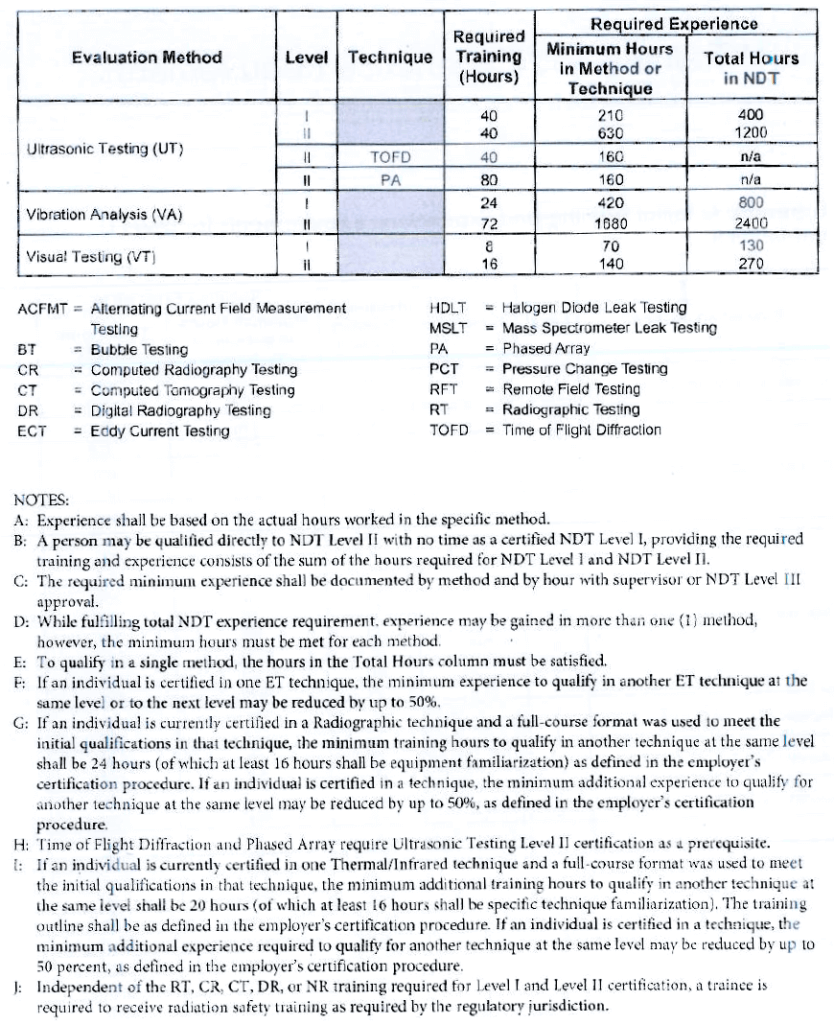
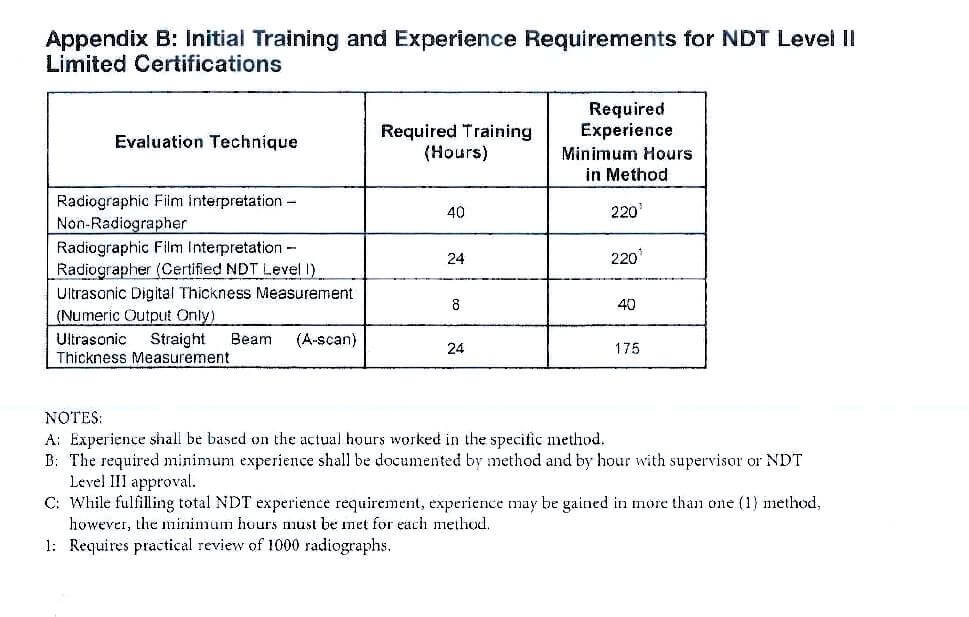
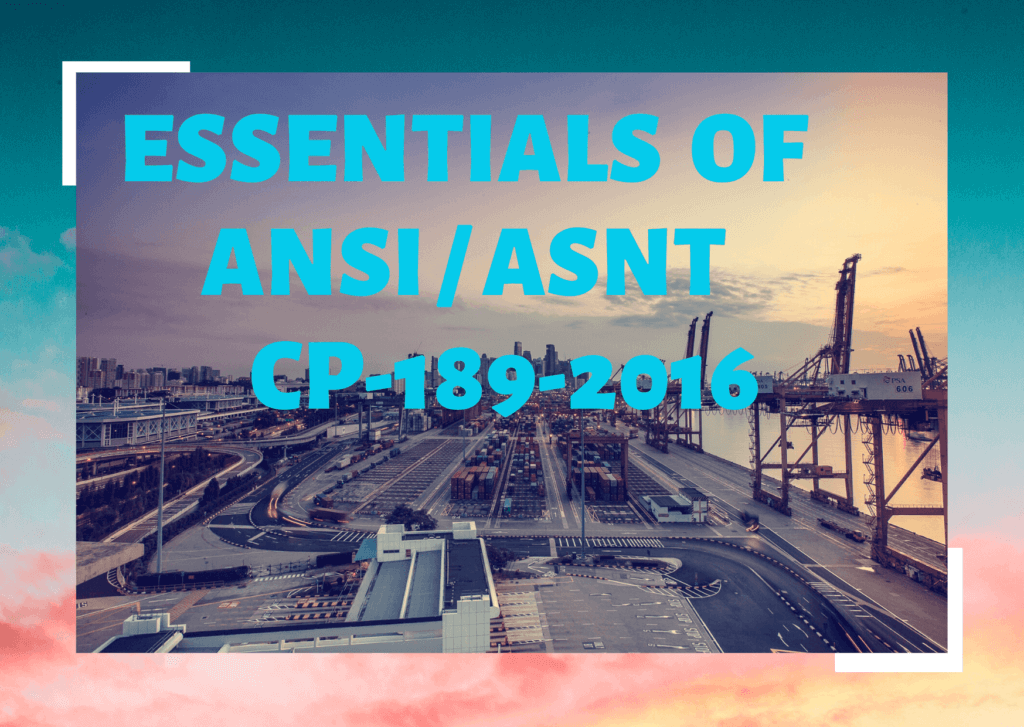
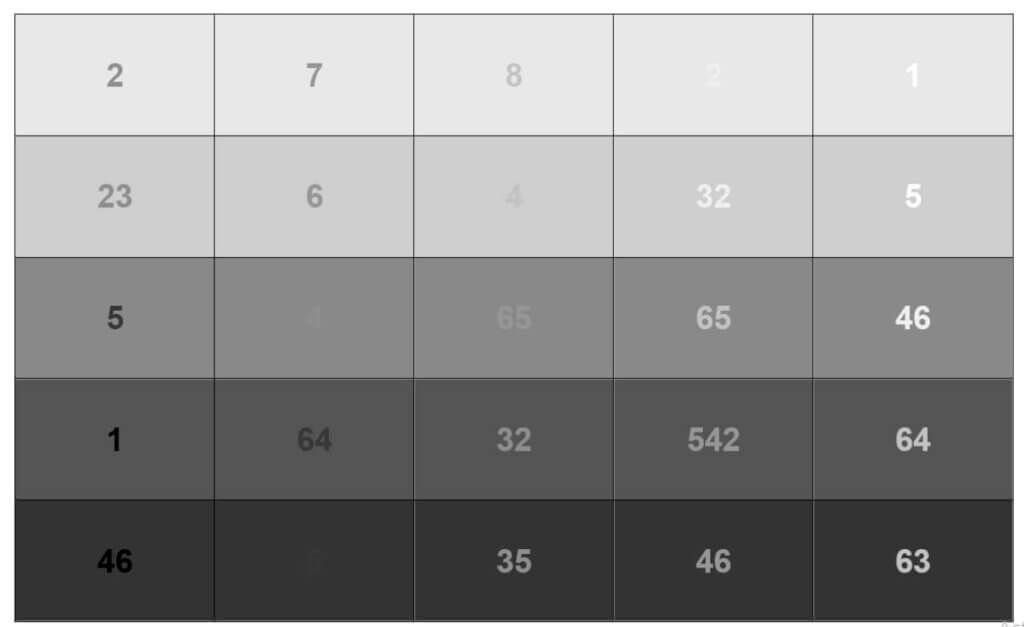
It’s a pity you don’t have a donate button! I’d most certainly donate to this outstanding blog! I suppose for now i’ll settle for book-marking and adding your RSS feed to my Google account. I look forward to new updates and will talk about this website with my Facebook group. Talk soon!
Your appreciation is enough for us. Thankyou very much.
Excellent read, I just passed this onto a friend who was doing a little research on that. And he actually bought me lunch since I found it for him smile Thus let me rephrase that: Thanks for lunch!
Appreciate you sharing, great article post.Really looking forward to read more. Fantastic.
Very good read/info – a must for anyone preparing for Basic LVL III Exams
According to cp 189 and Snt tc 1a the recommended training hours are as per education or regardless education?
It is regardless of education.
Do you have a list of the 29 Sect XI exceptions up CP189?
regret